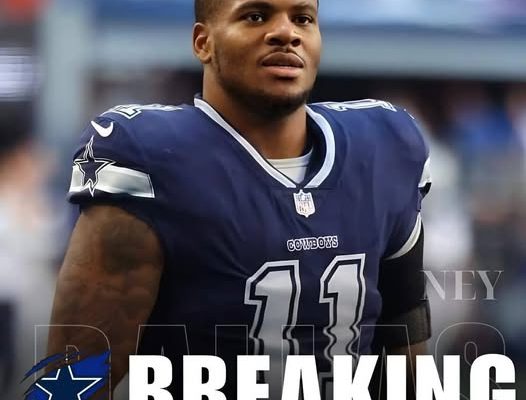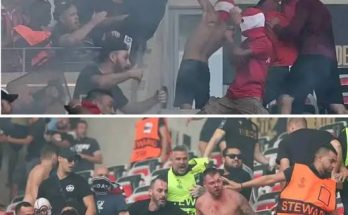Micah Parsons’ journey to becoming the highest-paid non-quarterback in NFL history is more than just the story of a lucrative deal—it is a moment that reshapes how the league values elite defensive players and a declaration from the Dallas Cowboys that they are committed to building their future around one of the most dynamic and disruptive forces the game has seen in years. The reported \$108 million guaranteed that comes with his record-setting contract is not just a staggering figure—it’s a statement to the rest of the NFL that Dallas is willing to put their financial and competitive chips squarely on the table for a player they believe can tilt games, seasons, and perhaps even Super Bowl odds in their favor. This is a bold play, and while some have labeled it risky given the size and guaranteed nature of the contract, there is little doubt that Parsons has already established himself as a rare breed—one capable of transcending the traditional value metrics for linebackers and pass rushers.
Parsons’ impact has been immediate since entering the league, and that impact is measurable in a way that makes this investment far less of a gamble than the skeptics might suggest. From his rookie year, when he burst onto the scene as a Defensive Rookie of the Year and a near-unanimous All-Pro selection, to his continued dominance as both a pass rusher and off-ball linebacker, Parsons has consistently demonstrated that his skill set cannot be contained in a single position description. He lines up on the edge, off the ball, in the slot, and even occasionally drops into coverage—making him a nightmare for offensive coordinators who must game plan for a player with both the speed to chase down receivers and the strength to bull rush the league’s best tackles. That type of versatility is exactly why the Cowboys were willing to go to unprecedented financial lengths to secure him.
What makes this deal particularly intriguing is the timing. The Cowboys could have waited another year or even considered playing the fifth-year option game before getting serious about an extension, but they acted now. This early commitment reflects an organizational philosophy shift for a franchise that in the past has been criticized for letting negotiations drag on too long, often leading to inflated market prices or, worse, losing a star player. This time, Dallas decided to set the market rather than react to it. By doing so, they not only locked in Parsons but also sent a clear message to current and future players: if you perform at an elite level, the team will reward you before anyone else has a chance to make a higher offer.
From a league-wide perspective, this deal changes the landscape for defensive player contracts. In recent years, we’ve seen pass rushers like Nick Bosa, T.J. Watt, and Myles Garrett reset the market for edge defenders, but Parsons’ deal now sits at the top of that mountain. And unlike some of those players, Parsons is not a pure edge rusher—he’s a hybrid defensive weapon whose unique skill set commands a premium because of the strategic flexibility he gives the Cowboys defense. This versatility allows defensive coordinator Mike Zimmer to design game plans that keep offenses guessing and to move Parsons around in ways that force opponents to account for him on every snap. If you’re an opposing quarterback, you have to know where Parsons is before the ball is snapped. That constant mental pressure is as valuable as his physical production.
Still, there are those who argue that guaranteeing \$108 million to a non-quarterback is inherently risky, especially given the physical demands of Parsons’ role. Pass rushers and linebackers take constant punishment, and injuries can derail even the most promising careers. But the Cowboys are betting on Parsons’ unique combination of athleticism, work ethic, and football intelligence to mitigate those risks. He has shown remarkable durability and the ability to adapt his game when teams attempt to neutralize him. In a sport where quarterbacks often dominate the headlines and salary cap space, Dallas is essentially saying that a player of Parsons’ caliber can be just as valuable as a top-tier quarterback in terms of determining wins and losses.
The financial commitment also speaks to the Cowboys’ current competitive window. With Dak Prescott at quarterback, CeeDee Lamb ascending as one of the league’s premier wideouts, and a defense loaded with young talent, Dallas is in position to make a legitimate run at a championship. In that context, securing Parsons long-term is as much about maximizing their shot at a Super Bowl over the next few years as it is about rewarding individual excellence. In today’s NFL, where defensive playmakers can swing games with a single strip sack, pick-six, or key stop on third down, Parsons’ ability to change momentum is worth its weight in gold—or in this case, over a hundred million dollars.
Beyond the on-field impact, Parsons has also emerged as a central figure in the Cowboys’ brand identity. He is charismatic, media-savvy, and not afraid to speak his mind—a combination that plays perfectly in a market like Dallas, where star power is part of the franchise DNA. Jerry Jones understands the value of having a face of the franchise on both sides of the ball, and Parsons fits that bill as well as anyone since DeMarcus Ware patrolled the edge for the Cowboys. Locking him up now ensures that the Cowboys have a defensive anchor who can also be a public ambassador for the team.
Parsons’ journey to this moment is itself a testament to both his talent and his relentless drive. Coming out of Penn State, he was regarded as one of the most physically gifted players in his draft class, but there were questions about whether he could translate his college production to the NFL level, especially after opting out of the 2020 season due to COVID-19 concerns. Those doubts evaporated quickly as Parsons racked up sacks, quarterback hits, and pressures at an elite rate. His rare burst off the line of scrimmage and ability to bend around the edge immediately drew comparisons to some of the game’s all-time great pass rushers, and he’s only gotten better since then.
There’s also a cultural component to this contract that shouldn’t be overlooked. For years, the narrative around the Cowboys has been that they are a talented but underachieving team, prone to playoff disappointments despite star-studded rosters. By making Parsons the highest-paid non-quarterback in league history, the Cowboys are signaling that they are serious about building a championship-caliber roster from the inside out, starting with a defense that can dominate when it matters most. Parsons embodies that vision—he is young, hungry, and still improving, and his presence elevates the play of those around him.
Critics may point to the opportunity cost of such a massive deal. Every dollar committed to Parsons is a dollar that cannot be spent elsewhere, and with Lamb, Prescott, and other key players also seeking extensions, the salary cap math will get complicated. But this is where the Cowboys’ front office believes they can manage the roster and cap smartly. Elite players command elite money, and the reality is that you cannot win consistently in the NFL without paying your best players top dollar. By securing Parsons now, Dallas may actually save money in the long run, avoiding a bidding war or the inflation that will inevitably come as the cap continues to rise.
The ripple effects of this deal will be felt across the league. Other star defenders and their agents will now point to Parsons’ contract as the new benchmark, particularly those who, like Parsons, can impact the game in multiple ways. Younger players entering the league will see that versatility and playmaking ability are rewarded at the highest levels, potentially inspiring a new generation of hybrid defenders. In that sense, Parsons’ deal is not just a personal milestone but a moment that could influence defensive philosophy and player development for years to come.
For Parsons himself, the challenge now shifts from earning the contract to justifying it in the eyes of fans, teammates, and critics. Fair or not, with a record-breaking deal comes heightened expectations. Every sack, every missed tackle, every penalty will be scrutinized. But if his first few seasons are any indication, Parsons thrives under pressure. He has the kind of competitive fire that feeds on big moments, and with the financial security of this deal, he can focus entirely on bringing a championship back to Dallas.
This is more than just a business transaction. It’s a bet on talent, leadership, and the belief that one player can change the trajectory of an entire franchise. The Cowboys have placed that bet on Micah Parsons, and in doing so, they have reshaped the conversation about how much a defensive player can be worth in the modern NFL. The money is eye-popping, but for Dallas, the real payoff will come if Parsons can lead them back to the Super Bowl stage and finally end the decades-long championship drought. Until then, this contract will stand as both a bold declaration of faith and a challenge to Parsons to continue being the game-wrecking force who made this deal possible in the first place.
If he delivers, this will be remembered not as a risky move, but as one of the smartest investments in NFL history—a moment when the Cowboys recognized generational greatness and refused to let it slip away.



